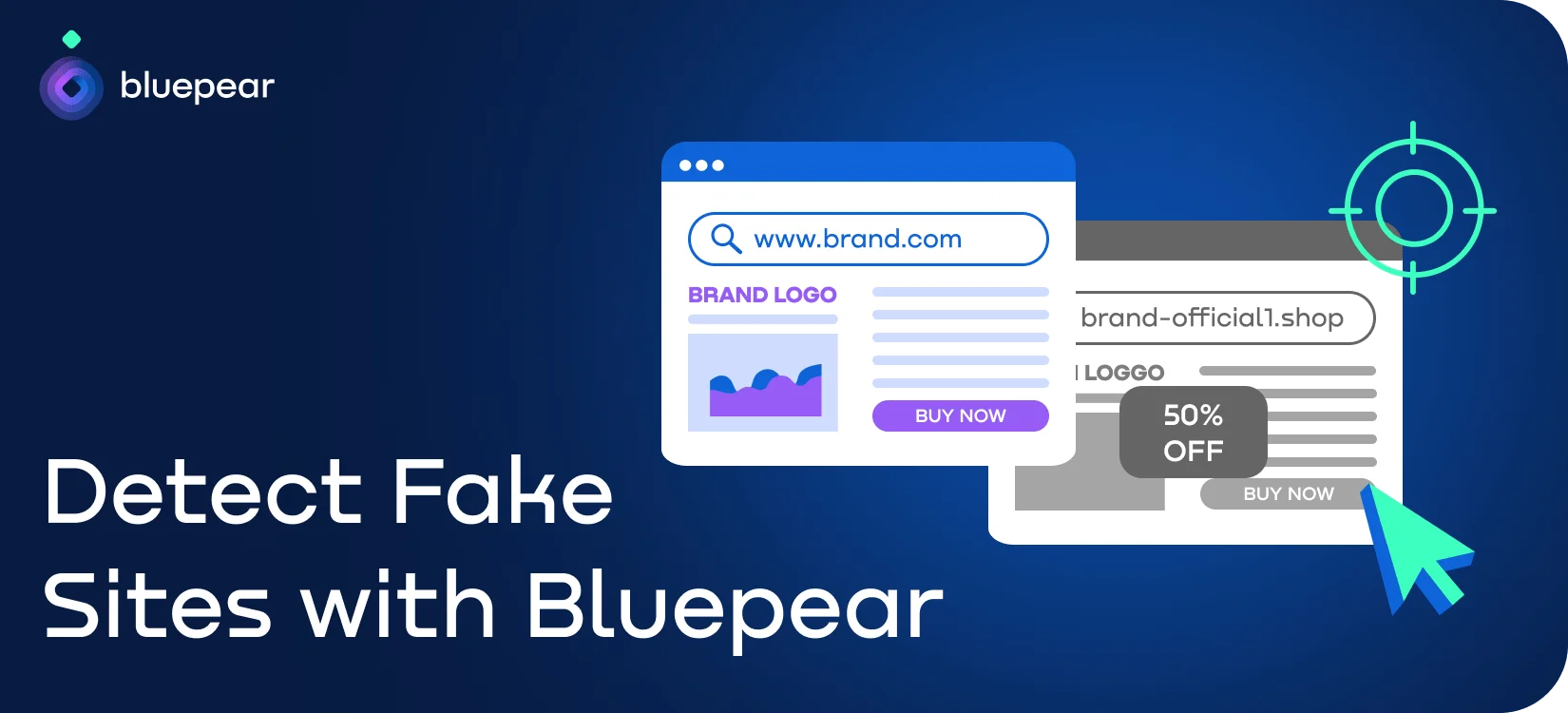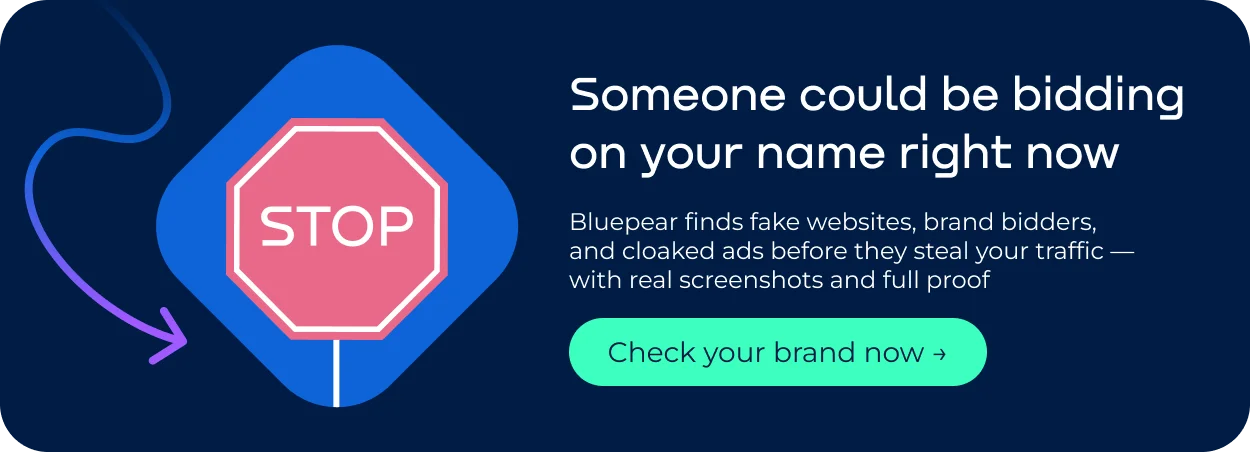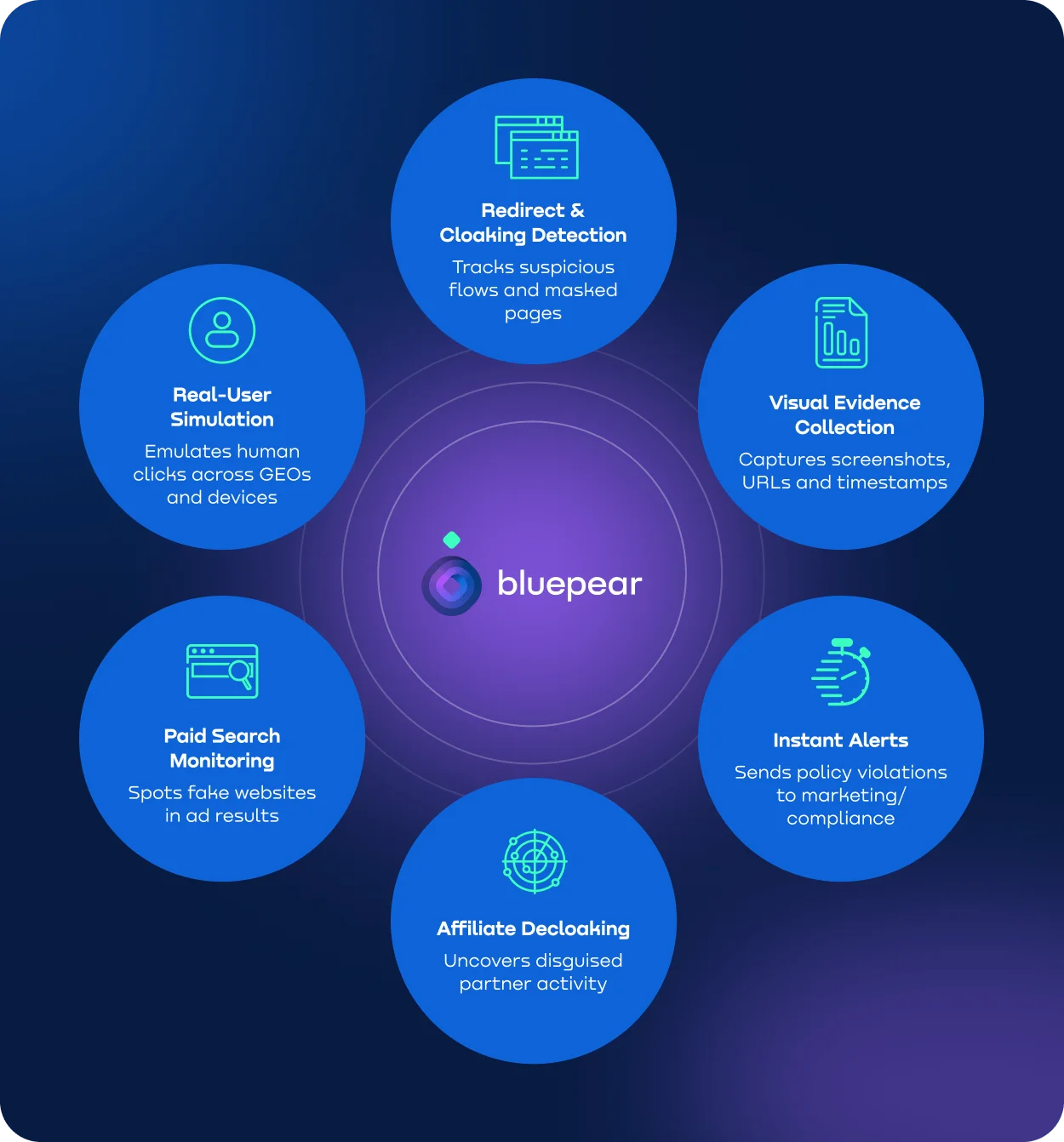
Contents
In 2024, Google blocked or removed 415 million ads and 5 million advertiser accounts due to violations related to fraud and brand impersonation. This means that millions of fraudulent ads and fake company websites were actively targeting users before being taken down. It highlights the massive scale of abuse and the ongoing threat to brand safety, ad budgets, and consumer trust.
This isn’t just a compliance issue buried in fine print. It’s a marketing problem which is growing fast. So, there’s a real chance that someone is bidding on your name, mimicking your site, and hijacking clicks meant for you.
- • Global brand losses from impersonation across online channels totaled $6.8 billion in 2023.
- • Malicious ads placed in search results (sometimes even mimicking trusted sites) grew 41% in late 2023.
- • Between 2022 and 2023, the number of phishing domains and fake websites grew by 27% globally.
What makes things worse is how invisible fraud can be. Your campaign reports won’t show you which fake domains are stealing your traffic. But the damage shows up as lower conversion rates, higher bounce rates, and strange dips in brand traffic.
This article is for marketers who own their performance and protect their brand. We'll break down how fake websites spoil paid search, what it costs your brand, and what you can do to protect your campaigns. If you care about ROI, brand integrity, and not wasting your budget, keep reading.
What Are Fake Websites And Why They Matter to Marketers
Fake websites are deceptive web pages designed to look legitimate while serving malicious or manipulative goals. In the context of marketing, their primary purpose is to intercept branded traffic, steal user data, and divert clicks away from authentic campaigns.
These sites often appear in paid search results, targeting users who are actively looking for a specific brand. They mimic real landing pages and trick users into clicking, converting, or entering personal information. From the outside, they look like real brand assets. But behind the scenes, they reroute value away from the brand and toward fraudsters.
The goals of fake websites typically fall into five categories:
-
1. Traffic theft. Capturing paid or organic brand traffic and redirecting it elsewhere.
-
2. User deception. Tricking users into believing they’re interacting with a trusted brand to harvest data, money, or logins.
-
3. Click interception. Bidding on branded keywords and diverting users to a fake company website before the brand can convert them.
-
4. Data theft. Stealing sensitive personal or payment information through fake login pages, checkout forms, or contact fields on phishing domains.
-
5. Affiliate abuse. Redirecting users through hidden affiliate links to earn illegitimate commissions off the brand’s own paid or organic traffic.
These sites often rely on tactics such as:
- • Domain spoofing. URLs that closely resemble real brand domains (e.g., yourbrandd.com instead of yourbrand.com)
- • Authentic-looking templates. Designs that copy the brand’s look and feel to build trust instantly
- • Cloned landing pages. Near-identical replicas of real product or login pages
In many cases, these fake websites stay live just long enough to do real damage before ad platforms detect and take them down.
For marketers, it’s a direct hit to performance, budget efficiency, and brand trust.
How Fake Websites Get Into Google Ads
Fake websites use a mix of tricks to sneak into paid search. Here’s how it works:
-
- Scammers buy a web address that looks like a real brand site. It might include a hyphen, a misspelling, or a different extension like .net or .online. To the average user, it seems legit.
-
- They create an ad account and run ads on branded keywords like “YourBrand login” or “YourBrand support.” The ad copy looks convincing, the domain passes basic checks and Google approves it.
-
- When someone clicks the ad, it first opens a clean-looking page, then quickly redirects them to the actual fake company website. This helps avoid detection by ad reviewers and automated systems.
-
- The user lands on a page that mimics the brand’s design. It may ask for login credentials, payment info, or push them to call a fake support number.
This setup is fast, cheap, and dangerous. It steals traffic and wastes ad spend before most brands even know it’s happening.
How Fake Websites Connect with Affiliate Fraud
Fake websites aren’t just a standalone threat. They often play a central role in affiliate fraud. In paid search and performance marketing, there are typically two ways a fake business website gets involved. Effective affiliate marketing management requires knowing how fraudsters piggy-back on your campaigns, so we’ll examine the two most common hijack scenarios below.
In the first variant, scammers pose as affiliates. In this case, fraudsters set up fake websites that mimic legitimate affiliate landing pages. They use domain spoofing and fake websites with cloned designs to appear trustworthy.
These sites pass through affiliate networks, often going undetected at first. Once approved, they start stealing branded traffic and funneling users to unauthorized or deceptive offers while collecting commissions.
Alternatively, rogue affiliates build fake sites themselves. Sometimes, real affiliates go beyond gray tactics and create fake websites or use ad hijacking to inflate their performance.
They may bid on branded keywords or even clone the brand’s actual landing pages. These affiliates redirect traffic through their own tracking links to claim last-click credit without delivering real conversions.
In both cases, fraudsters use methods like:
- • Domain spoofing that looks like brand sites.
- • Cloaking to show clean pages to reviewers and fake ones to users.
- • Redirect chains that obscure the true destination.
To combat this, Bluepear uses decloaking technology that can expose hidden redirects and cloaking behaviors. It allows marketers to detect affiliate abuse in real time, spot phishing domains posing as affiliates, and cut off harmful traffic sources before they escalate.
How Fake Websites Harm Brands
Domain fraud hits brands where it hurts most: visibility, performance, and trust. Their impact spans both paid search and affiliate programs, creating losses that are hard to detect but easy to feel.
- • Steal branded traffic. They intercept clicks from users actively searching for your brand diverting high-intent visitors before they reach your site.
- • Drive up CPCs. They compete with your campaigns on branded keywords, forcing you to pay more just to stay visible in search results.
- • Break attribution. They use redirects and cloaking that scramble tracking, distort performance metrics, and undermine marketing decisions.
- • Damage reputation. They mimic your brand’s look and voice, misleading users and eroding trust, especially when scams are tied back to your name.
| Problem | Paid Search Impact | Affiliate Program Impact |
|---|---|---|
| Traffic diversion | Lost clicks and conversions | Fraudulent leads and stolen commission credit |
| Higher keyword competition | Increased CPCs on branded terms | Affiliates outbidding the brand on its own keywords |
| Analytics distortion | Inaccurate attribution and conversion tracking | Inflated performance reports, misaligned payouts |
| User deception | Drop in trust, poor experience | Compliance issues, complaints tied to brand name |
| Brand impersonation | Confusion in SERPs, ad fatigue | Legal and reputational exposure |
How to Spot a Fake Company Website
Fake websites are built to trick users but marketers and affiliate managers can catch them by looking for certain patterns. Watch for these red flags to spot fake websites:
- • Suspicious domains. Extra words, hyphens, typos, or non-standard extensions like .click, .support, .online, instead of the brand’s usual domain.
- • Low-quality content. Broken layouts, generic or mismatched text, outdated branding, missing legal pages.
- • Fake login prompts. “Sign in with Google” or email forms designed to steal credentials.
- • Design inconsistencies. Stretched logos, wrong fonts, off-brand colors, broken CTAs.
Redirect behavior is another giveaway of domain fraud. To test it:
- • Click the link and carefully watch the address bar. Does the URL change mid-load?
- • Use a redirect checker to trace the full path behind the ad or link.
- • Make sure the final landing page matches the ad copy and expected brand destination.
To confirm a site’s legitimacy, compare the URL letter by letter with the official domain, check for HTTPS and a valid SSL certificate.
Also pay attention to traffic signals. Sudden spikes, unfamiliar referrers, high click-through but no conversions may all point to domain fraud stealing your paid or affiliate traffic.

What to Do When Find a Fake Website
Fake websites can go live, run ads, and damage your brand within hours. If you discover one, acting fast and methodically is critical. Here’s what to do:
1. Collect evidence.
Before reporting, make sure you have clear proof. This strengthens your takedown request and speeds up platform response.
Gather the following:
- • Screenshots of the fake website, ad copy (if visible), and search results.
- • The full URL, including tracking parameters and redirects.
- • A click-flow recording or step-by-step notes showing how the user lands on the fake business website from search or an ad.
Bluepear automatically collects all the necessary evidence and sends you them in one report.
2. Report to relevant platforms.
Once documented, file complaints with:
- • Google Ads. Use Google’s trademark complaint form or phishing domain report tools
- • Hosting provider. Use WHOIS data to find the hosting company and submit an abuse report via their website
- • ICANN. If the site is part of a pattern or the host is unresponsive, file a complaint at icann.org.
- • Affiliate network. If applicable, report the abuse through your affiliate dashboard or account manager
Each report should include your evidence and a clear description of how the fake business website is impersonating your brand.
3. Automate violation tracking.
Manual takedowns are reactive. So, by the time you act, the damage may already be done. Fake sites can rotate domains, use cloaking, or disappear and return under new names. That’s why automated search ad monitoring matters.
Tools like Bluepear help brands detect domain spoofing, unauthorized ads, and affiliate abuse in real time. They also automatically log redirects, click paths, and screenshots as evidence, monitor branded keyword usage across search engines, and accelerate takedown enforcement.
How Bluepear Helps to Combat Fake Websites
Bluepear is an automated monitoring tool designed to keep your brand safe. The tool 24/7 scans search results and ad placements to spot unauthorized bidding or misuse of branded terms. Blupear catches all the violations due to its tailored algorithm. The tool:
- • Bluepear mimics real clicks from different devices, locations, and browsers just like a real customer. This helps detect what fraudsters actually show to users, not what platforms see during ad reviews.
- • Tracks every step of the user journey , including hidden redirects, affiliate hops, and cloaked landing pages. This reveals when traffic is being hijacked or misrouted.
- • Detects cloaking and hidden behavior. The tool uncloaks websites to see what real users see and catch the violations.
- • Captures visual evidence. The platform logs screenshots of search ads, landing pages, and redirect chains. All evidence is timestamped and stored for documentation or takedown requests.
- • Sends real-time alerts. When a violation is detected, Bluepear sends alerts to your team instantly.
Also, Bluepear supports both affiliate and brand protection. Whether you're managing partner traffic or defending your brand in search, Bluepear gives you visibility and control across paid and organic channels.

Best Practices to Fight Against Fake Websites
Fake websites are fast-moving and hard to catch. These steps help marketers stay ahead:
✅ Register common brand name variations and typos as domains to prevent domain spoofing.
✅ Monitor branded keywords in search ads to spot unauthorized bidding.
✅ Regularly audit affiliate partners and their landing pages for compliance.
✅ Check search results from different regions and devices to catch geo-targeted scams.
✅ Document and report any suspicious domains or redirects as soon as they appear.
✅ Track redirect chains and ad paths to reveal hidden fake sites.
✅ Verify all paid traffic sources, especially sudden spikes with poor performance.
✅ Use real-time monitoring tools like Bluepear to detect violations before they spread.
✅ Set up alerts for brand keyword abuse, unauthorized ads, and domain fraud.
✅ Keep screenshots, URLs, and click paths as evidence for fast enforcement.
Strong brand protection starts with visibility. Automation makes it faster, smarter, and always on.
FAQ
What is a fake website?
A fake business website is a page designed to look like a real brand site but is controlled by scammers. It may copy your layout, use a similar domain name, and trick users into thinking it’s legit while stealing clicks or data.
What’s the difference between domain spoofing and a phishing domain?
A spoofed domain is a lookalike URL, like yourbrand-support.com, meant to confuse users. Phishing is the act of collecting personal info through deception. Domain spoofing is often used for phishing, but they may also just redirect traffic to get more affiliate commissions.
Why does Google Ads allow this?
Google has systems to catch abuse, but fake sites can slip through by looking clean on the surface. Scammers often hide bad behavior behind redirects or cloaking, which makes it harder for automated checks to catch them before ads go live.
How can Bluepear detect this?
Bluepear monitors branded search results, affiliate traffic, and ad activity in real time. It catches hidden redirects, domain spoofing, cloaking, and unauthorized ad placements, so that brands can take action fast.
What if the fake site is already live?
Report it immediately through your ad platform or affiliate network. If you're using Bluepear, it can track the fake’s behavior, document the abuse, and help build a case for takedown or enforcement.

